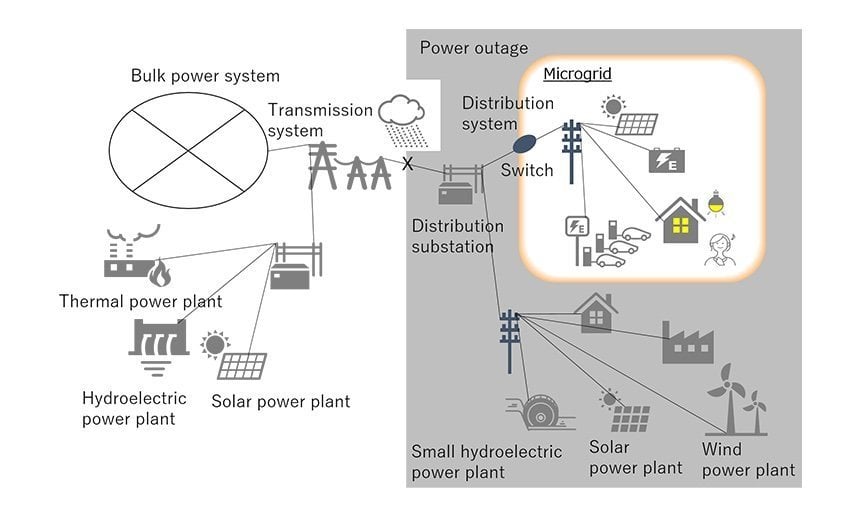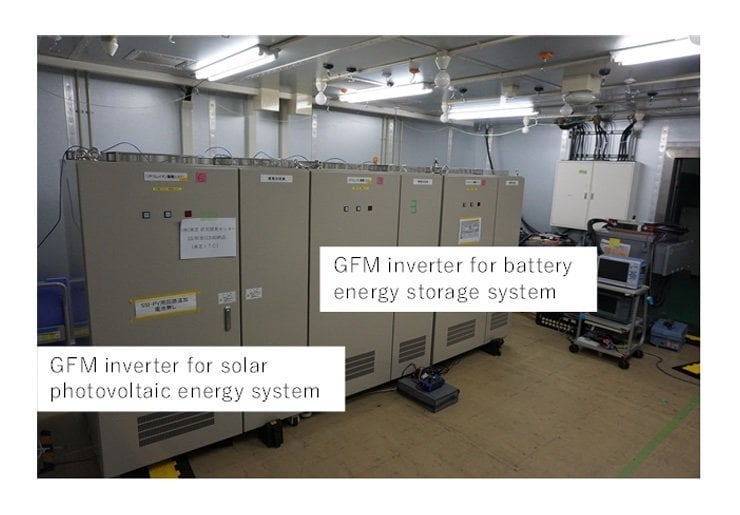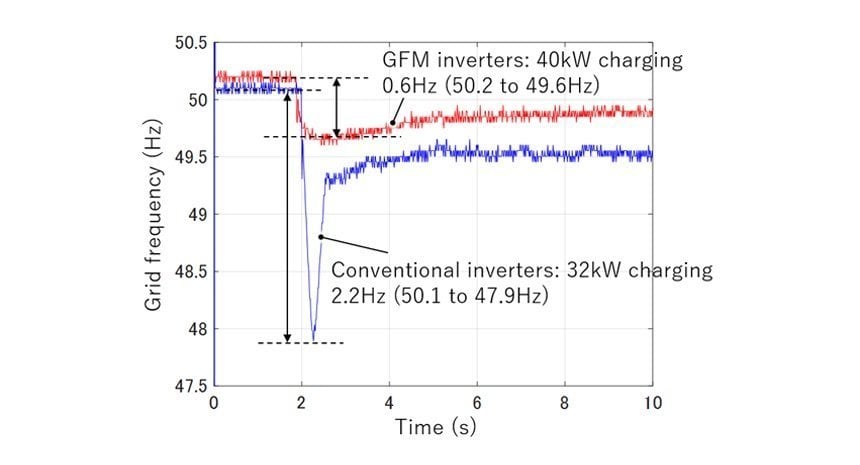www.magazine-industry-usa.com
26
'22
Written on Modified on
Toshiba Demonstrates the Effectiveness of Grid-forming Inverters in Preventing Power Outages due to Fluctuations in Renewable Energy Output and Sudden Changes in Demand to Ensure Stable Microgrid Operation
Grid-forming inverters applied to solar photovoltaic energy systems mitigate grid frequency drops by about 30%, promote the use of microgrids, and realization of a carbon-neutral society.

Toshiba Corporation has demonstrated the effectiveness of its grid-forming (GFM) inverter, which was developed to ensure the stability of microgrids. A microgrid is a type of distributed energy system that enables regional self-sufficiency for electric power through the use of renewable energy, rather than relying on power supply from large-scale power plants. When there is a sudden fluctuation in the output of or demand for electric power, a normally stable frequency can fluctuate drastically, possibly triggering a protection relay(*1) and cutting off power supply, leading to power outages. In particular, as the share of renewable energy increases, fluctuations in grid frequency increase. In particular, frequency fluctuations will increase with increased ratios of renewable energy, so the widespread use of microgrids will require technologies for maintaining a stable grid frequency.
In March 2022, Toshiba developed a GFM inverter that can maintain the grid frequency of distribution systems by providing pseudo-inertia through power output from the inverter when the grid frequency rapidly fluctuates. The company has now verified the results of using GFM inverters in a setting similar to real environments, including the actual use of renewable energy, and has demonstrated that mounting GFM inverters on photovoltaic power generators suppresses decreases in grid frequency by approximately 30%.
Toshiba plans to present details of these results at the Annual Conference of the Power and Energy Society of the Institute of Electrical Engineers of Japan in September 2022 and at the 2022 IEEE Energy Conversion Congress and Exposition (ECCE2022) in October 2022.
Toshiba commissioned this research under “The Smart Synchronous Inverter (SSI) and its control systems based on virtual synchronization with power girds to utilize power from multiple renewable energy sources” as part of the Ministry of the Environment’s fiscal 2019–2021 Project for Low Carbon Technology Research, Development and Demonstration Program. This work was conducted in collaboration with Pacific Power Co., Ltd., Energy & Environment Technology Research Institute, National Institute of Advanced Industrial Science and Technology, and Pacific Consultants Co., Ltd.

The developed prototype GFM inverter.
Features of the technology
Toshiba developed a prototype GFM inverter that provides synthetic inertia and suppresses the fluctuations of the grid frequency in distribution systems even when fluctuations in power supply or power demand occur and demonstrated its effectiveness. Toshiba has implemented a control algorithm of the GFM inverter(*4) in battery energy storage systems instead of conventional control algorithm without inertia , and when there are rapid fluctuations in renewable energy output or power demands, the inverter outputs power and generates a synthetic inertia to maintain the grid frequency. This instantly suppresses sudden drops in frequency, realizing a stable power supply.
Toshiba had also conducted a verification of this inverter implemented in a simulated microgrid. The simulated microgrid assumed the grid frequency of 50 Hz (the grid frequency used in eastern Japan) and a 40% renewable energy rate, combining five battery energy storage systems (20 kW rating, 14.9 kWh battery capacity) equipped with GFM inverters, one diesel synchronous generator (125 kVA rating) with an internal combustion engine, and two load banks used to vary the power load (*5). In that verification, it was demonstrated that under load fluctuations of 50 kW, grid frequency reductions were suppressed by 70%, from 2.4 Hz (50.0 to 47.6 Hz) to 0.6 Hz (50.0 Hz to 49.4 Hz). The frequency threshold for power supply interruptions due to grid frequency fluctuations in East Japan is set at 48.5 Hz (*6), and verifications using actual equipment ensured that the frequency did not fall below this threshold, demonstrating the realization of a stable power supply that avoids power outages. This is the world's first demonstration of parallel operation of a diesel synchronous generator and inverter(*7).
To verify the effects of the GFM inverter in a state similar to real-world conditions, Toshiba conducted a verification test using only one solar photovoltaic energy system (20 kW rating) and one diesel synchronous generator (125 kVA rating) equipped with a GFM inverter, instead of using the battery energy storage systems equipped with a GFM inverter. In this verification, it was demonstrated that the decrease in grid frequency was suppressed by approximately 30%, from 1 Hz (50.0 to 49.0 Hz) to 0.7 Hz (50.0 to 49.3 Hz) when the load fluctuation was 20 kW.
In the configuration combined with the energy storage systems (*8) we also verified the effect of suppressing the decrease in grid frequency by 70%, from 2.2 Hz (50.1 to 47.9 Hz) to 0.6 Hz (50.2 to 49.6 Hz), both when discharging storage batteries and when recharging them. This is expected to contribute to grid stability when charging electric vehicles. Toshiba also verified that instantaneous load on the GFM inverter can be reduced by 30%, from 22 to 16 kW, by selecting an inertia suitable for parallel operation of synchronous generators with internal combustion engines, like those expected to be used in a microgrid.


Verification of photovoltaic power generation applying the GFM inverter and a diesel synchronous generator with an internal combustion engine.

Verification of actual equipment when recharging batteries.

Power sharing of generators for different inertia in GFM inverter.
Development background
In October 2020, the Japanese government declared the goal of achieving carbon neutrality by 2050 and, with the aim of realizing a decarbonized society, is promoting the use of solar power, wind power, and other forms of renewable energy as main power sources. The Sixth Strategic Energy Plan, approved by the Cabinet on October 22, 2021, states that “to utilize distributed energy resources such as renewable energy and cogeneration in local communities, we hope to see the creation of microgrids and other self-reliant and distributed energy systems, which will also contribute to efficient energy use through local production for local consumption, strengthen resilience, etc.,” indicating growing expectations for microgrids that can provide power self-sufficiency on outages due to disasters, etc.
Overseas, in addition to addressing environmental issues, there have been multiple projects in Asian and African countries to build microgrids utilizing renewable energy and storage batteries that will supply electricity to areas where electric power networks are undeveloped (off-grid areas). As of 2015, the worldwide microgrid capacity exceeded 12,000 megawatts(*2), and further expansion is expected in the future.
In a conventional bulk power system, even in the event of fluctuations in demand or renewable energy output, the inertial (the property that tries to maintain a state) of rotating bodies such as turbines used for thermal power generation suppress rapid changes in system frequency, thus maintaining a stable power supply. However, if renewable energy becomes the main power source in the future and there is a decreased ratio of power sources such as thermal power generation that use large turbines, then there will be less inertial force from rotating bodies, which may affect the stability of electric power supply. Estimated costs for measures to deal with such a shortage of inertia range from 5.1 to 12.9 billion yen per year if the ratio of renewable energy in the bulk power system becomes 50%–60%(*3).
Solar and wind power are assumed to be the main power sources in microgrids, which are small-scale energy systems as compared to bulk power system. The amount of power generated fluctuates depending on the weather, and there is no connection to thermal power plants that use large turbines. As a result, power supply instability due to a lack of inertia will be even more pronounced. To ensure microgrid stability, it will therefore be essential to develop technologies to compensate for lack of inertia and stabilize power supplies, and to demonstrate these technologies and put them into practical use as soon as possible.
Future developments
To realize a decarbonized society by 2050, the Japanese government has formulated its “Regional Decarbonization Roadmap” for developing measures through collaboration and co-creation between the national and local governments, and has indicated a policy for “realizing decarbonized, robust, and vibrant communities across the country, without waiting for 2050.” With the aim of utilizing the GFM inverter developed for microgrids, Toshiba will continue to engage in research, development, and demonstrations for early commercialization.
*1 A device that rapidly detects abnormal conditions in the power system or power facilities and issues commands for quickly disconnecting sections where an abnormality has occurred from other, healthy parts.
*2 Scope for the establishment of IEC TC8 international standardization. IEC - TC 8 Dashboard> Scope
*3 Organization for Cross-regional Coordination of Transmission Operators, Japan, Committee on Adjustment Capability and Supply–Demand Balance Evaluation, 64th Meeting of the Committee on Adjustment Capability and Supply–Demand Balance Evaluation, Document 3: “Status of considerations of technical issues and measures for dealing with them when shifting to renewable energy as the main source of power” (August 23, 2021)
*4 Y. Noro, "Proposal of inverter control method for electric power system consisting of energy storages", IEEJ Trans. PE, vol. 138, no. 11, pp. 854-861, 2018.
*5 https://ieeexplore.ieee.org/document/9755962
*6 Organization for Cross-regional Coordination of Transmission Operators, Japan, Request for change of Under Frequency Relay (UFR) settling value in grid-connected generators
*7 Toshiba research as of April 2022
*8 A microgrid system comprising a 125-kVA SG and five 20-kVA battery energy storage systems
www.toshiba.com

